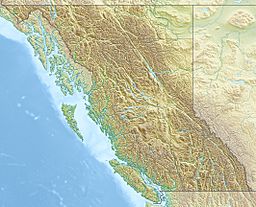Hobson Lake facts for kids
Quick facts for kids Hobson Lake |
|
|---|---|
| Location | British Columbia |
| Coordinates | 52°30′00″N 120°20′00″W / 52.50000°N 120.33333°W |
| Primary inflows | Clearwater River and Hobson Creek |
| Primary outflows | Clearwater River |
| Max. length | 35 km (22 mi) |
| Max. width | 1.5 km (0.9 mi) |
| Surface elevation | 858 m (2,815 ft) |
| Islands | 1 |
| Settlements | None |
Hobson Lake is a beautiful lake located in east-central British Columbia, Canada. It's the highest lake on the Clearwater River and is one of the six main lakes found within the amazing Wells Gray Provincial Park.
Contents
Exploring Hobson Lake's Surroundings
The lake is surrounded by tall mountains. To the east, you'll see peaks from the Cariboo Mountains that rise almost 2,000 meters (6,500 feet) above the lake. Some of these peaks include Twin Spires and Mount Hugh Neave. Mount Hugh Neave is the seventh tallest mountain in Wells Gray Park, reaching 2,829 meters (9,281 feet) high. It's named after Hugh Neave, a brave mountaineer who explored many peaks in the park during the 1960s and 1970s. He was the first to climb Garnet Peak, the park's third highest mountain, in 1974. West of Hobson Lake, the land is called the Quesnel Highland, but it doesn't have any named mountains close to the lake.
A Look Back: History and Naming
Hobson Lake is named after John B. Hobson. He was a very important person in British Columbia. He showed how well a mining method called hydraulic placer mining could work.
What is Hydraulic Placer Mining?
In this mining method, powerful jets of water are used. These jets wash away banks of gravel that contain gold. The gravel then goes into special channels called sluices. Inside the sluices, the gold separates from the gravel.
John B. Hobson's Story
John B. Hobson was born in Ireland in 1844. He later moved to New York and studied mining. In 1892, he came to Canada. He was invited by the Canadian Pacific Railway to explore areas in the Cariboo District. These areas were known to have lots of gold-bearing gravel. He started two big mining companies. These were the largest and most modern attempts at hydraulic mining in British Columbia at that time. However, due to a lack of money, his projects didn't become very successful.
Early Gold Searches at Hobson Creek
Thomas Drummond was one of the first people to look for gold at Hobson Creek. This creek flows into the upper part of Hobson Lake. He built a dam and a long channel to direct the water. He spent a lot of money, but he didn't find much gold. He wrote that the area had too many large rocks from glaciers. These rocks made it almost impossible to dig for gold.
Later, in 1914, another company bought Drummond's property. They worked to improve the road between Quesnel Lake and Hobson Lake. In 1915, a small steamboat carried mining equipment across Hobson Lake. From there, horses carried supplies further up the creek. Miners dug tunnels and built more dams and channels. They tried small-scale hydraulic mining. But most of these efforts failed because they didn't have enough money to properly test the gold deposits. Another company tried in 1920 but also found little success.
The Blue Ice Group
In 1923, a miner named Fred Wells found some gold and silver. This was at a branch of Hobson Creek now called Fred Wells Creek. He named his discovery the "Blue Ice Group." This name was perfect because the site was very high up, at 2,075 meters (6,808 feet). It was only 60 meters (200 feet) away from an active glacier! Even though there was a good amount of gold and silver found in 1938, the site was never fully developed. This was because the nearby glacier moved in unpredictable ways.
Reaching Hobson Lake: A Wilderness Adventure
There is no road that goes to Hobson Lake. Visiting the lake today is a true wilderness experience. It requires a lot of planning and good survival skills.
Trails and Challenges
- A trail, 13 kilometers (8 miles) long, starts at the end of Clearwater Lake. It leads to the outlet of Hobson Lake.
- This trail is often in poor condition, with many fallen trees.
- A big danger is crossing Lickskillet Creek. This is because the 40-meter (130-foot) high Sundt Falls is just downstream.
- You can rent canoes at Hobson Lake if you arrange it beforehand with Clearwater Lake Tours. This company can also give you a boat ride to the start of the trail.
- Another way to reach the lake is an old, overgrown trail. This trail connects Quesnel Lake and Hobson Lake. It's what's left of the old mining road.
- There are no trails from the lake to the high mountain meadows. Reaching the treeline is very hard because of thick bushes.
- The Kamloops Mountaineering Club tried to climb Mount Hugh Neave twice in the 1990s. Both times, they had to turn back because of the difficult conditions.
Air Access
Access by air is limited. You need a special permit from B.C. Parks to land a float plane or helicopter at Hobson Lake.


